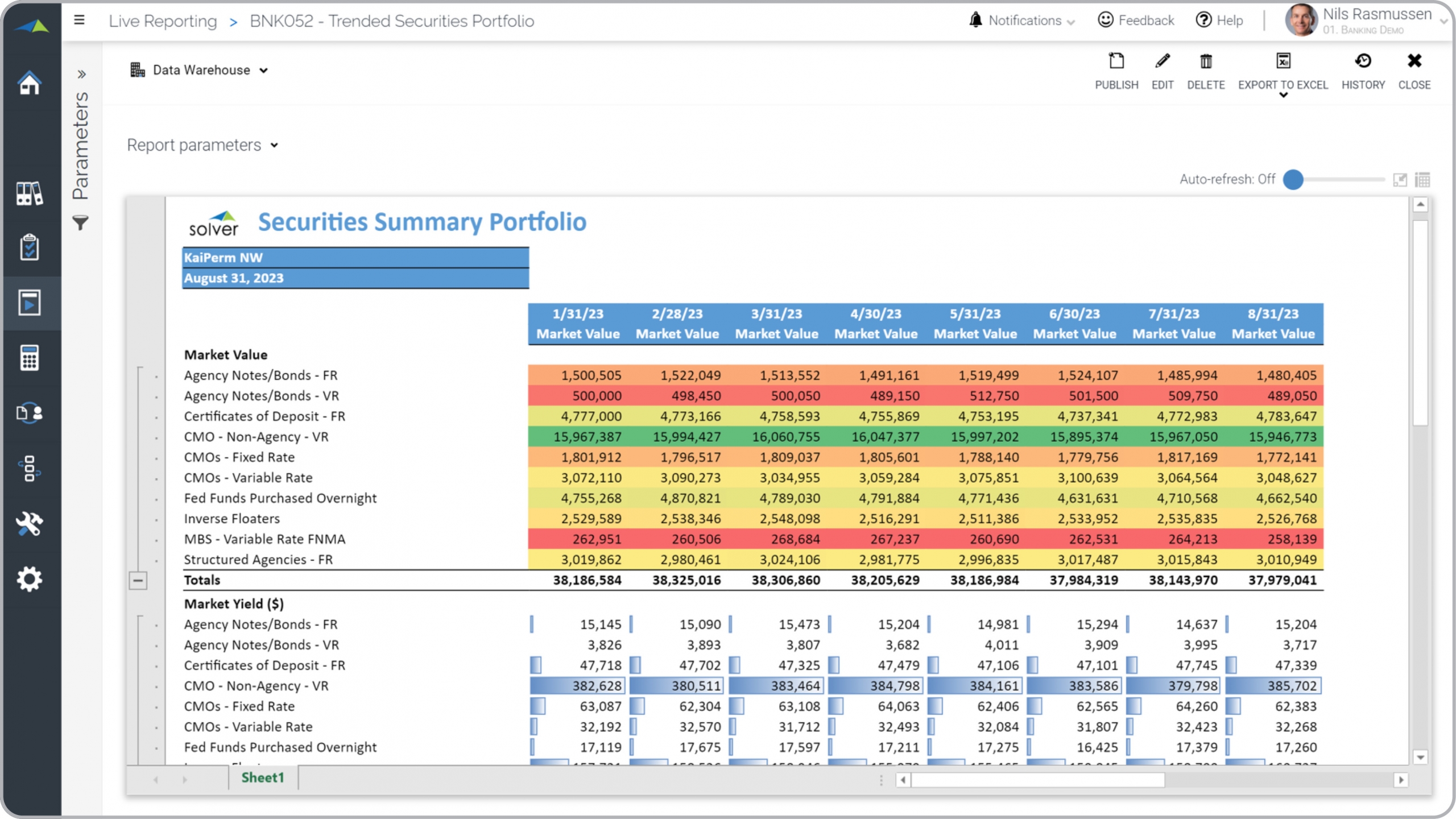Trended Securities Summary Report for Banks
What is
a
Trended Securities Summary Report for Banks
? Trended Securities Summary Reports are considered monthly trend analysis tools and are used by investment managers and analysts to monitor monthly trends in their portfolio. Some of the main functionality in this type of monthly trend report is that it dynamically lists months up to the current period across the columns with market yield in percent and amount figures down the rows. The top section (not visible in the screenshot below) shows the current market value of each security type. Color coding at the cell level helps the user quickly see high and low performing months and securities. You find an example of this type of monthly trend report below.
Purpose of
Trended Securities Portfolio Reports Banks use Trended Securities Portfolio Reports to easily discover trends and compare security values and yields. When used as part of good business practices in Investment- and Finance Departments, a bank can improve its securities strategies and profitability, and it can reduce the chances that important trends and outliers are discovered later than necessary.
Example of a
Trended Securities Portfolio Report Here is an example of a Trended Securities Summary Report with monthly values and yields by security category. [caption id="" align="alignnone" width="2560"]
 Example of a Trended Securities Summary Portfolio Report for Banks[/caption] You can find hundreds of additional examples
here
Who Uses This Type of
Monthly Trend Report
? The typical users of this type of monthly trend report are: Investment managers, securities portfolio managers, analysts.
Other Reports Often Used in Conjunction with
Trended Securities Portfolio Reports Progressive Investment- and Finance departments sometimes use several different Securities Portfolio Reports, along with securities transaction reports, investment dashboards, KPI dashboards, securities dashboards and other management and control tools.
Where Does the Data for Analysis Originate From? The Actual (historical transactions) data typically comes from securities management software and enterprise resource planning (ERP) systems like: Microsoft Dynamics 365 (D365) Finance, Microsoft Dynamics 365 Business Central (D365 BC), Microsoft Dynamics AX, Microsoft Dynamics NAV, Microsoft Dynamics GP, Microsoft Dynamics SL, Sage Intacct, Sage 100, Sage 300, Sage 500, Sage X3, SAP Business One, SAP ByDesign, Acumatica, Netsuite and others. In analyses where budgets or forecasts are used, the planning data most often originates from in-house Excel spreadsheet models or from professional corporate performance management (CPM/EPM) solutions.
What Tools are Typically used for Reporting, Planning and Dashboards? Examples of business software used with the data and ERPs mentioned above are:
Example of a Trended Securities Summary Portfolio Report for Banks[/caption] You can find hundreds of additional examples
here
Who Uses This Type of
Monthly Trend Report
? The typical users of this type of monthly trend report are: Investment managers, securities portfolio managers, analysts.
Other Reports Often Used in Conjunction with
Trended Securities Portfolio Reports Progressive Investment- and Finance departments sometimes use several different Securities Portfolio Reports, along with securities transaction reports, investment dashboards, KPI dashboards, securities dashboards and other management and control tools.
Where Does the Data for Analysis Originate From? The Actual (historical transactions) data typically comes from securities management software and enterprise resource planning (ERP) systems like: Microsoft Dynamics 365 (D365) Finance, Microsoft Dynamics 365 Business Central (D365 BC), Microsoft Dynamics AX, Microsoft Dynamics NAV, Microsoft Dynamics GP, Microsoft Dynamics SL, Sage Intacct, Sage 100, Sage 300, Sage 500, Sage X3, SAP Business One, SAP ByDesign, Acumatica, Netsuite and others. In analyses where budgets or forecasts are used, the planning data most often originates from in-house Excel spreadsheet models or from professional corporate performance management (CPM/EPM) solutions.
What Tools are Typically used for Reporting, Planning and Dashboards? Examples of business software used with the data and ERPs mentioned above are:
- Native ERP report writers and query tools
- Spreadsheets (for example Microsoft Excel)
- Corporate Performance Management (CPM) tools (for example Solver)
- Dashboards (for example Microsoft Power BI and Tableau)
Corporate Performance Management (CPM) Cloud Solutions and More Examples
September 10, 2021
TAGS:
Reporting,
Solver,
report writer,
Microsoft,
gross yield,
template,
practice,
Acumatica,
Netsuite,
Finance,
monthly trend,
planning,
GP,
fintech,
life value,
Business Central,
excel,
gross life,
ax,
securities portfolio,
market value,
securities,
forecast,
Budget,
Dynamics 365,
analysis,
budgeting,
portfolio analysis,
bank,
Cloud,
Software,
Tableau,
SAP,
example,
best,
book value,
Sage,
BC,
D365,
NAV,
Intacct,
securities summary,
financial institution,
CPM,
report,
branch,
SL,
Management,
dynamics,
Power BI

